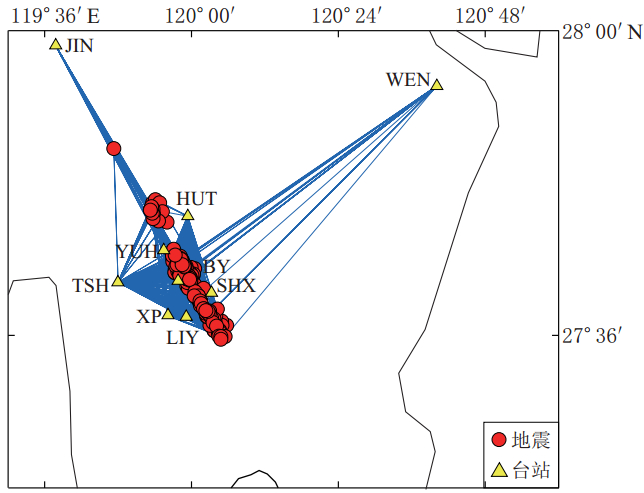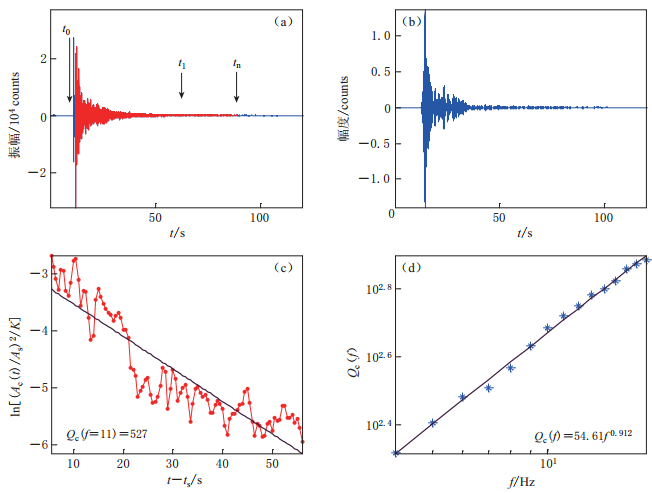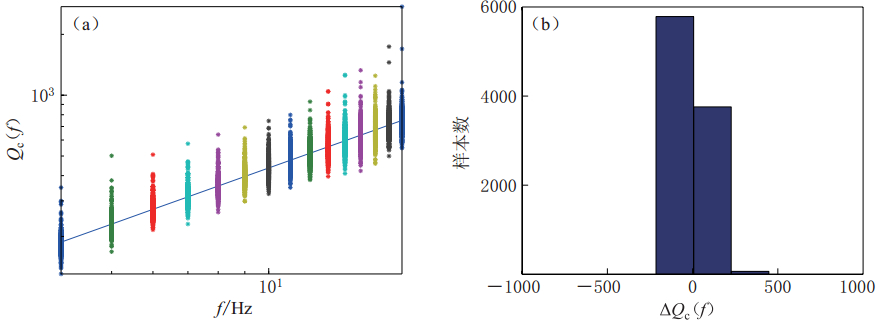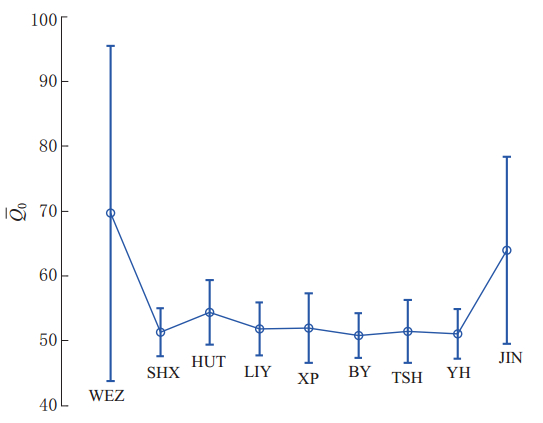Characteristics of seismic wave attenuation in Shanxi Reservoir area of Zhejiang Province
-
摘要: 2002—2007年发生的珊溪水库地震事件是少震、 弱震的浙江省区域显著的地震事件. 搜集182次ML>2.0地震的近场台站数字地震波形, 使用这些波形高信噪比的尾波时间域信号, 根据计算尾波Qc(f)值的Sato模型, 通过滤波及去除环境噪声, 计算了地震波传播路径上的尾波Qc(f)值; 拟合Qc(f)值与频率f之间的关系, 分析了水库区域地震波衰减的时空特征. 根据信噪比及计算要求, 从近场9个台站的记录中挑选出641条三分向记录, 计算尾波衰减参数, 得到尾波Qc(f)与频率f的关系为: Qc(f)=52.19±7.11f0.922 1±0.05. 结果表明, 本区域为低衰减区域. 震群活动使区域介质对高频率波衰减趋势性增大. 进一步对尾波衰减参数及尾波采样体之间的关系分析发现, 该区域存在深部高衰减层.Abstract: The earthquakes which occurred from 2002 to 2007 in Shanxi Reservoir area, Zhejiang Province, are very notable, because the province is not considered prone to earthquakes. We have collected waveform data of 182 ML>2.0 earthquakes recorded at near-source stations. By using the coda time series with high signal-to-noise ratio and filtering the data to eliminate background noises based on Sato model, the coda Qc(f) was calculated, and the relationship between Qc(f) and frequency (f) was obtained. Then, the characteristics of seismic wave attenuation in the reservoir area were analyzed. 641 three-component records chosen from 9 stations were used for this study. Our result shows that the relationship between the coda Qc(f) and f is: Qc(f)=52.19±7.11f0.9221±0.05, suggesting that the study area is a tectonically inactive zone. The attenuation coefficient for high frequency waves increases with seismic activity. Further analysis on the relationship between Qc(f) and sampling depth reveals that high attenuation layers exist deep beneath the study area.
-
Keywords:
- earthquake swarm /
- coda /
- attenuation coefficient /
- reservoir earthquakes
-
-
图 1 台站、 震中及射线分布图(震中引自朱新运等,2010) WEZ: 温州台; JIN: 景宁台; HUT: 黄塘台;YUH: 云湖台; TSH: 泰顺台; BY: 包洋台;XP: 新浦台; SHX: 珊溪台; LIY: 联云台
Figure 1. Seismic stations (triangles),epicenters (circles) and ray-paths (blue solid lines)
图 2 尾波衰减参数计算过程实例(a) 使用波形原始记录(仅绘EW向),tn表示满足信噪比条件的尾波截断点,t1表示尾波计算实际使用的尾波截断点,t0表示地震发震时刻(t1-t0=60 s); (b) f=11(f±1/3f)数据滤波实例; (c) 主频率为f=11的数据拟合; (d) Qc(f)与频率关系
Figure 2. Examples of coda wave attenuation parameter calculation (a) E- -W component velocity seismogram,tn represents cutoff point of coda waves satisfying signal-to-noise ratio (SNR) condition,t1 denotes cutoff point of coda waves used in the calculation,t0 is the origin time (t1-t0=60 s); (b) Filtered seismogram (f=11(f±1/3f)); (c) Data fitting with f=11; (d) Relationship between Qc(f) and frequency
图 3 全区域所有台站记录的尾波衰减参数与频率关系 (a) Qc(f)与频率关系图,星号表示实测的Qc(f)值,实线表示衰减参数与频率的依赖关系; (b) 数据残差分布
Figure 3. Qc(f) values versus frequency for all stations in the whole region (a) Relationship between Qc(f) and frequency,asterisk represents measuredQc(f),solid line shows Qc(f)-frequency dependency relation for the whole region; (b) Residual distribution
图 4 TSH台获得的Qc(f)与频率关系 (a) Qc(f)与频率关系图,星号表示实测的Qc(f)值,实线表示衰减参数与频率的依赖关系; (b) 数据残差分布
Figure 4. Qc(f) obtained as a function of frequency for TSH station (a) Relationship between Qc(f) and frequency,asterisk represents measured Qc(f),solid line shows the Qc(f)-frequency dependency relation for the whole region; (b) Residual distribution
图 6
This page contains the following errors:
error on line 1 at column 1: Start tag expected, '<' not foundBelow is a rendering of the page up to the first error.
Figure 6.
This page contains the following errors:
error on line 1 at column 1: Start tag expected, '<' not foundBelow is a rendering of the page up to the first error.
表 1 各台站数据统计结果
Table 1 Statistical results of Q value from different stations

表 2 国内外不同区域尾波衰减参数比较
Table 2 Comparison of coda attenuation parameters obtained at home and abroad

-
刘芳, 苗春兰, 高艳玲. 2007. 内蒙古中西部地区尾波Q值研究[J]. 地震, 27(1): 72-75. 刘希强, 石玉燕, 曲均浩, 周彦文, 李红, 李铂, 张坤. 2009. 品质因子的尾波测定方法讨论[J]. 中国地震, 25(1): 11-23. 师海阔, 朱新运, 贺永忠, 张立恒. 2011. 基于Sato模型的宁夏及邻区尾波Q值研究[J]. 地震, 31(1): 118-126. 魏红梅, 贺曼秋, 黄世源, 王同军. 2009. 重庆荣昌地区尾波Qc值特征[J]. 西北地震学报, 31(1): 97-100. 于俊谊, 朱新运. 2008. 浙江珊溪水库地震震源参数研究[J]. 中国地震, 24(4): 379-387. 朱新运, 杨钢宇, 张震峰. 2005. 基于Sato模型的近震S波尾波Q值求解及分析软件研制[J]. 地震地磁观测与研究, 26(3): 63-70. 朱新运, 刘杰, 张帆. 2006. 基于Aki模型的近震S波尾波Q值求解及分析软件研制[J]. 地震研究, 29(1): 76-80. 朱新运, 张帆, 于俊谊. 2010. 珊溪水库精细地震定位及构造研究[J]. 中国地震, 26(4): 380-391. Aki K. 1969. Analysis of the seismic coda of local earthquakes as scatter waves[J]. J Geophys Res, 74(2): 615-631.
Aki K, Chouet B. 1975. Origin of coda waves: Source, attenuation and scattering effects[J]. J Geophys Res, 80(23): 3322-3342.
Amerbeh W B, Fairhead J D. 1989. Coda Q estimates in the Mount Cameroon volcanic region, West Africa[J]. Bull Seism Soc Amer, 79(5): 1589-1600.
Carpenter P J, Sanford A R. 1985. Apparent Q for upper crustal rocks in the central Rio Grande Rift[J]. J Geophys Res, 90(B10): 8661-8674.
Castro R R, Cecilio J R, Inzunza L, Orozco L, Sánchez J, Gálvez O, Farfán F J, Méndez I. 2003. Direct body wave Q estimates in northern Baja California Mexico[J]. Phys Earth Planet Inter, 103(1-2): 33-38.
Domínguez T, Rebollar C J. 1997. Regional variations of seismic attenuation from coda and Lg waves in northern Baja California[J]. J Geophys Res, 102(B7): 15259-15268.
Drouet S, Souriau A, Cotton F. 2005. Attenuation, seismic moments, and site effects for weak-motion events: Application to the Pyrenees[J]. Bull Seism Soc Amer, 95(5): 1731-1748.
Gao L S, Lee L C, Biswas N N, Aki K. 1983a. Comparison of the effects between single and multiple scattering on coda waves for local earthquakes[J]. Bull Seism Soc Amer, 73(2): 377-389.
Gao L S, Biswas N N, Lee L C, Aki K. 1983b. Effects of multiple scattering on coda waves in three-dimensional medium[J]. Pure Appl Geophys, 121(1): 3-15.
Herraiz M, Espinosa A F. 1987. Coda waves: A review[J]. Pure Appl Geophys, 125(4): 499-577.
Horasan G, Guney A B. 2004. S-wave attenuation in the Sea of Marmara, Turkey[J]. Phys Earth Planet Inter, 142(3-4): 215-224.
Jacobson R S, Shor G G, Shor J, Bée M. 1984. A comparison of velocity and attenuation between the Nicobar and Bengal deep sea fans[J]. J Geophys Res, 89(B7): 6181-6196.
Liu Z, Wuenscher M E, Herrmann R B. 1994. Attenuation of body waves in the central New Madrid seismic zone[J]. Bull Seism Soc Amer, 84(4): 1112-1122.
Nava F A, Arthur R G, Castro R R, Suarez C, Marquez B, Cornu F N, Saavedra G. 1999. S wave attenuation in the coastal region of Jalisco-Colima, Mexico[J]. Phys Earth Planet Inter, 115(3): 247-257.
Petukhin A, Irikura K, Shiro O, Kagawa T. 2003. Estimation of Q-values in the seismogenic and aseismic layers in the Kinki region, Japan, by elimination of the geometrical spreading effect using ray approximation[J]. Bull Seism Soc Amer, 93(4): 1498-1515.
Pitt A M, Hill D P, Walter S W, Jonson M J S. 2002. Midcrustal, long-period earthquakes beneath Northern California volcanic areas[J]. Seism Res Lett, 73(2): 144-152.
Pulli J J. 1984. Attenuation of coda waves in New England[J]. Bull Seism Soc Amer, 74(4): 1149-1166.
Sato H. 1977. Energy propagation including scattering effects: Single isotropic scattering approximation[J]. J Phys Earth, 25: 27-41.
Wong V, Cecilio C J, Munguía L. 2001. Attenuation of coda waves at the Tres Vírgenes volcanic area, Baja California Sur, México[J]. Bull Seism Soc Amer, 91(4): 683-693.





 下载:
下载:







